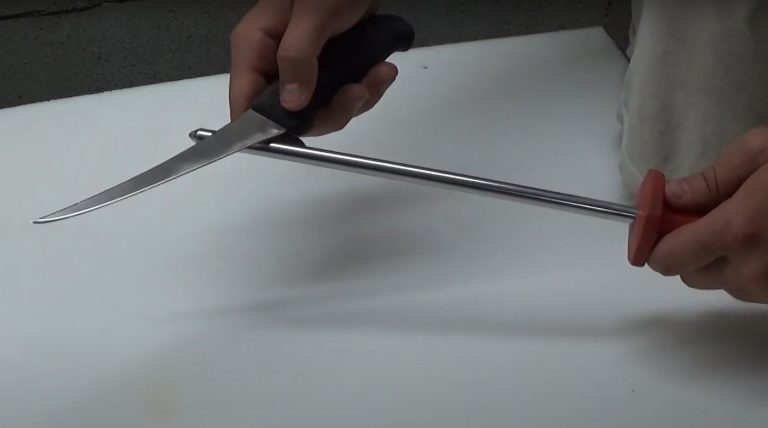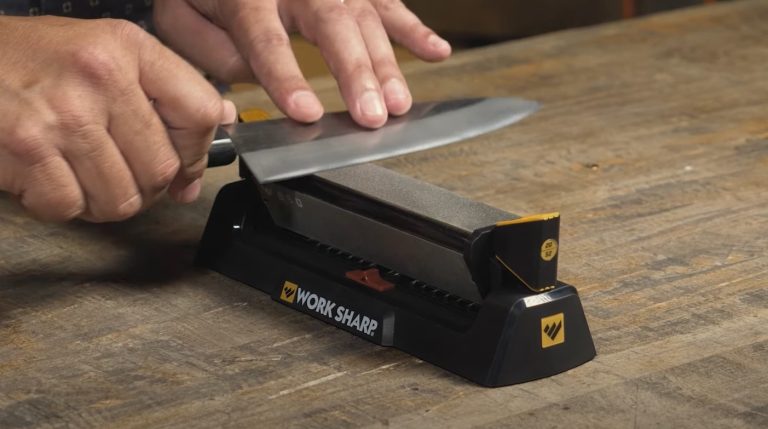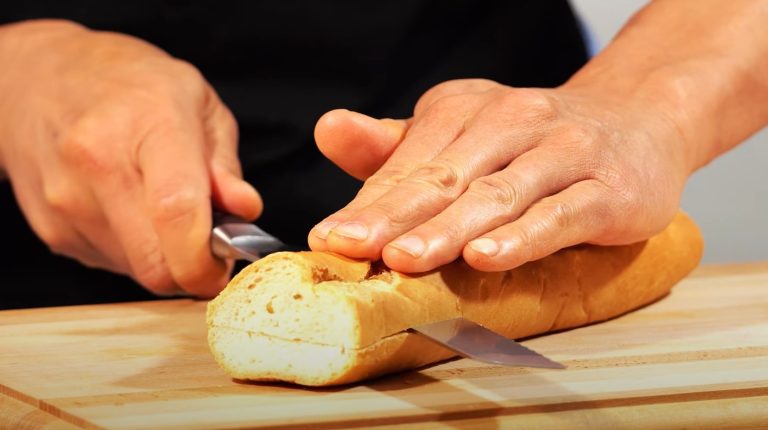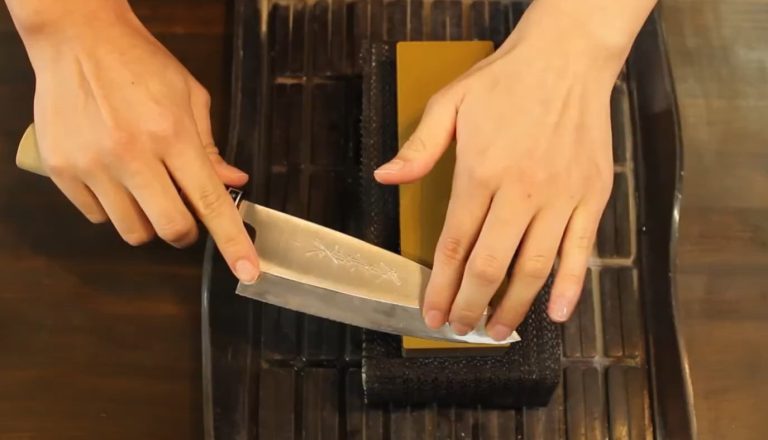Ceramic vs Steel Honing Rod: Pros, Cons and Expert Tips
When deciding between ceramic and steel honing rods, consider their unique features. Ceramic rods provide a finer edge but are fragile, while steel rods are durable and ideal for realigning blades.
If you use high-carbon or delicate knives, ceramic may be your best bet, while steel suits general use. Both require different maintenance methods, impacting their longevity.
Exploring these factors can help you choose the right honing rod for your needs. More insights await for your knife care journey.
Key Takeaways
- Ceramic honing rods polish edges effectively but are brittle and prone to breakage if mishandled.
- Steel honing rods are durable and impact-resistant, making them ideal for everyday use and rough handling.
- Ceramic rods require minimal maintenance and are best for high-carbon and delicate knives, while steel rods need regular drying to prevent rust.
- Ceramic honing rods provide a finer edge, whereas steel rods excel at realigning blades, particularly for thicker and German knives.
- Ceramic rods have a higher initial cost but offer long-term value; steel rods are more affordable and versatile for general use.
Material Composition
When choosing between ceramic and steel honing rods, it’s essential to understand their material composition, as it directly impacts performance and suitability for different knives.
Ceramic honing rods, made from hardened materials like aluminum oxide, are non-reactive and lightweight, making them perfect for delicate knives.
Their fine-grit surface polishes edges effectively but can be brittle if mishandled. Additionally, ceramic rods can last for years with proper care, ensuring they remain a reliable tool in your kitchen.
In contrast, steel honing rods, typically crafted from high-carbon steel, excel in durability and versatility. They provide aggressive honing capabilities and come in various grits to address different dullness levels. Some steel rods even feature diamond coatings for enhanced sharpening.
Durability Comparison
When comparing ceramic and steel honing rods, it’s essential to evaluate their material strength and resistance to breakage.
Ceramic rods, while effective, are more fragile and can break easily if dropped, whereas steel rods offer superior impact resistance. Additionally, steel’s longevity and lower maintenance requirements make it a more durable choice for regular use.
However, ceramic rods can maintain an edge effectively on harder steel knives, making them a preferred option for professional kitchens.
Material Strength Differences
While both ceramic and steel honing rods serve the essential purpose of maintaining knife edges, their material strength reveals significant differences in durability.
Ceramic rods boast a hardness that’s typically four times that of most knife steels, making them effective for honing. However, they’re more brittle and require careful handling.
This brittleness means that ceramic rods are best suited for infrequent use, ideally every 6 to 12 months. Additionally, excessive metal removal during honing can compromise the blade’s integrity over time.
In contrast, steel rods are renowned for their durability and resistance to physical stress, showcasing versatility in various grits and textures.
- Ceramic rods last for years with minimal maintenance but are prone to chipping.
- Steel rods withstand impacts better and are easier to maintain with proper care.
- Overall, steel’s durability makes it a more practical choice for everyday use.
Resistance to Breakage
Ceramic honing rods and steel honing rods exhibit distinct differences in their resistance to breakage, influencing their practical applications.
Ceramic rods are brittle, shattering easily if dropped, which requires you to handle them with care. In contrast, steel rods are more durable and can withstand rough handling and accidental impacts without breaking.
Regular honing with a steel honing rod not only helps maintain knife sharpness but also reduces the risk of blade damage during everyday use.
Durability tests consistently show that steel rods outperform ceramic options, making them preferred for long-term use. Their flexibility allows steel to absorb impacts better, minimizing the risk of breakage.
If you prioritize resilience in your honing rod, steel’s robustness makes it a more reliable choice, especially in busy kitchen environments where mishaps can occur.
Longevity and Maintenance
Understanding the longevity and maintenance of honing rods is essential for making an informed choice between ceramic and steel options.
Ceramic rods, known for their hardness, can last 10 to 20 years with proper care, while requiring minimal maintenance like a quick wipe with a damp cloth.
However, they must be handled cautiously to avoid breakage. Regular honing with a ceramic rod can help maintain knife effectiveness over time and prevent the need for frequent sharpening.
Steel rods, though generally more affordable, need regular drying to prevent rust and can be used frequently due to their durability.
- Ceramic rods excel in longevity and minimal upkeep.
- Steel rods offer cost-effectiveness but require more maintenance.
- Proper handling techniques are crucial for both types to extend their usable life.
Honing Mechanism and Effectiveness
When you’re honing a knife, the mechanism behind the honing rod plays an essential role in determining its effectiveness.
Ceramic honing rods utilize a fine-grit surface to delicately align your knife’s edge, removing microscopic metal for precision. In contrast, steel honing rods come in various grits that realign the blade’s teeth, often resulting in sharper edges due to their more aggressive nature.
While ceramic rods enhance sharpness by about 50%, steel rods can boost it by 60% or more. Ceramic rods offer greater control and less abrasion, making them ideal for softer knives. However, steel rods excel at removing imperfections, ensuring versatility for various blade types.
Additionally, ceramic honing rods are best suited for thin, delicate blades, while steel rods are preferred for everyday kitchen knives.
Suitable Knife Types
Selecting the right honing rod for your knife type is essential for maintaining its edge and overall performance. Understanding which honing rod suits your knife can prevent damage and enhance longevity.
- Ceramic Rods: Best for high-carbon, stainless, delicate, and Japanese knives, as they prevent chipping and maintain sharpness without abrasive wear. Regular use of ceramic honing rods helps reduce the frequency of knife sharpening by up to half. Additionally, carbon steel knives particularly benefit from ceramic rods due to their superior edge retention.
- Steel Rods: Ideal for German knives, thicker blades, and general-use knives, steel rods provide a more aggressive honing action, making them effective for removing nicks.
- Delicate or High-End Knives: Stick with ceramic rods to avoid damaging their fragile edges, while thicker or general-use knives can benefit from the robustness of steel rods.
Features and Design Variations
While choosing a honing rod, it’s crucial to take into account its features and design variations, as these elements directly influence performance and usability.
Ceramic rods boast hardness, making them effective for high-quality knives, while their smooth surfaces protect delicate edges. However, they can be brittle, necessitating careful handling.
Additionally, ceramic honing rods help maintain the knife edge longer, reducing the frequency of sharpening. Regular use fosters skill development, enhancing the user’s ability to maintain knife condition effectively.
Variations like built-in angle guides and ergonomic handles enhance usability, while options like steel cores improve durability.
On the other hand, steel rods offer various grits for different blade conditions. You’ll also find diamond-coated options for aggressive sharpening. These rods can provide precise angle control, allowing for a more customized sharpening experience.
Each design serves specific needs, so consider what aligns best with your knife maintenance routine to achieve ideal results.
Maintenance and Care Guidelines
To keep your honing rod in top condition, you’ll need to follow specific cleaning techniques and safe storage practices.
Regularly using the rod according to its intended frequency will also extend its lifespan and guarantee peak performance. Additionally, regular honing helps maintain knife sharpness between sharpenings.
Cleaning Techniques for Rods
When it comes to maintaining the effectiveness of honing rods, understanding the proper cleaning techniques for both ceramic and steel is vital.
For ceramic rods, use Bar Keepers Friend with an abrasive scrubby, rinse thoroughly, and dry to prevent water spots. You can also consider using 3 in 1 oil or a pencil eraser for gentle cleaning.
For steel rods, simply wipe with a damp cloth soaked in vinegar to remove debris and test functionality with a sharp knife. Regular cleaning is important for optimal performance, and no rinsing is usually needed, but drying is important to prevent rust.
- Regular cleaning prevents buildup.
- Handle ceramic rods with care to avoid breakage.
- Make sure steel rods are dry after cleaning to prevent rust.
Safe Storage Practices
Proper storage of honing rods is essential for maintaining their longevity and effectiveness. First, avoid impact by keeping ceramic rods in stable areas, as they’re brittle and can easily break. Store them in a dry environment to prevent moisture from damaging their performance.
Using protective cases or sleeves can shield your rods from dust and accidental damage. Positioning them vertically helps prevent bending or warping. Make sure they’re away from direct heat sources, which can alter their material properties.
Regularly inspect your rods for signs of wear, and handle them with care to avoid drops. Additionally, consider regular cleaning of ceramic rods to maintain their performance and prevent buildup of metal filings.
Choosing secure storage locations will further protect your honing rods from misplacement or environmental factors, making certain they stay in ideal condition.
Usage Frequency Recommendations
Storing honing rods correctly sets the stage for their ideal performance, but knowing how often to use them is equally important for maintaining your knives. For home cooks, use ceramic rods once or twice a week, while professionals might hone every hour.
Ceramic rods are gentle and suitable for delicate knives, ensuring edge maintenance without significant metal loss.
Steel rods, being more aggressive, can be used more frequently, but overuse may lead to metal removal. Regular honing helps preserve the knife’s edge and is essential for effective meal preparation.
- Use ceramic rods for precise sharpening of high-end knives.
- Employ steel rods for quick removal of nicks on Western knives.
- Regular honing can extend your knives’ lifespan by reducing the need for sharpening.
Cost and Value Analysis
While you might initially find ceramic honing rods more expensive due to their complex manufacturing process, it’s important to evaluate the long-term value they offer.
Ceramic rods excel in precision sharpening, making them ideal for high-quality knives, whereas steel rods are more budget-friendly and versatile.
Additionally, ceramic rods are recommended for harder knives as they maintain knife sharpness for longer. Here’s a quick cost and value comparison:
| Feature | Ceramic Rods | Steel Rods |
|---|---|---|
| Cost | Higher initial cost | More affordable |
| Longevity | Long-lasting with care | Durable, lasts decades |
| Maintenance | Minimal, non-reactive | Requires rust prevention |
Professional Preferences
Understanding the cost and value of honing rods sets the stage for exploring professional preferences.
Professionals typically choose honing rods based on the specific needs of their knives and the frequency of use.
- Ceramic rods are favored for delicate, high-end knives, especially Japanese styles, due to their non-reactive surface and fine grit. Regular visual inspections of the blade’s edge can help maintain optimal performance.
- Steel rods offer durability and versatility, making them suitable for frequent honing of stainless and high-carbon blades. Additionally, stainless steel rods have shown to improve sharpness by over 60%, making them a highly effective choice for maintenance.
- Honing technique is essential; professionals often hone more frequently than home cooks to maintain peak sharpness.
Choosing the Right Honing Rod for Your Needs
How do you choose the right honing rod for your specific needs? Start by considering the type of knife you own. If you have delicate, high-carbon blades, a ceramic rod is ideal for fine-tuning edges without aggressive abrasion.
Single bevel knives are particularly sensitive to improper sharpening techniques, making the choice of honing rod even more critical for maintaining their precision.
Consider your knife type: delicate, high-carbon blades pair best with ceramic rods for gentle edge refinement.
For versatility and durability, opt for a steel rod, which can handle various knife types. Next, think about the purpose of your knives—kitchen or hunting—as this influences your choice. Regularly testing knife performance helps to determine whether honing is necessary, ensuring that your chosen rod maintains optimal blade sharpness.
Length matters too; select a rod at least an inch longer than your longest knife. Finally, factor in your budget; ceramic rods are pricier but offer precision, while steel rods provide longevity and value.
Frequently Asked Questions
Can Ceramic Rods Be Used on All Knife Types?
Yes, you can use ceramic rods on various knife types, especially those with harder steels, like Japanese knives.
Their hardness makes them suitable for maintaining fine edges without removing excessive material.
However, while they work well on stainless and carbon steel knives, some users may still prefer steel rods for specific softer steels.
It’s important to take into account the knife’s Rockwell hardness and the condition of the edge for best results.
How Often Should I Hone My Knives With These Rods?
You should hone your knives regularly, evaluating their sharpness and usage.
For home cooks, honing once or twice a week is generally sufficient, while professionals might hone every hour during service.
If you’re using harder steel knives, you might need less frequent honing.
Always apply light pressure to maintain the edge without causing damage.
Are There Any Specific Brands Recommended for Honing Rods?
When you reach for a honing rod, think of it as a trusted companion, ready to bring your knife back to life.
For ceramic options, consider the Work Sharp or the Wedgek HXT for their precision. If steel’s your choice, the F. Dick Multicut and ZWILLING Kramer are top contenders, offering durability and control.
Each brand caters to specific needs, helping you maintain the sharpness that transforms your cooking experience. Choose wisely!
Can Honing Rods Sharpen Knives, or Just Maintain Them?
Honing rods don’t sharpen knives; they’re designed to maintain and realign the edge.
When you use a honing rod, you’re not removing metal but instead adjusting the microscopic teeth of the blade to keep it sharp longer.
Regular honing extends the time between sharpening sessions, ensuring your knife remains effective.
If your knife is truly dull or has a rolled edge, it’ll need proper sharpening, which goes beyond what honing rods can achieve.
What Is the Lifespan of Ceramic Vs Steel Honing Rods?
Think of honing rods as the guardians of your knives.
When it comes to lifespan, ceramic rods can last up to ten years with careful handling, but they’re brittle and can break easily.
Steel rods, on the other hand, are more durable and generally outlast ceramic options.
Proper maintenance, such as drying and avoiding moisture, is essential for both types, ensuring they serve you well for years to come.
Keep Your Blades Sharp and Your Cooking Sharper
In choosing between a ceramic and steel honing rod, consider your knife types and maintenance preferences.
Curiously, studies show that ceramic rods can maintain a sharper edge up to 30% longer than their steel counterparts, making them a compelling choice for precision. Ultimately, the right honing rod enhances your knife’s lifespan and performance, so weigh the durability and honing mechanisms carefully.
With the right tool, you’ll elevate your culinary experience and guarantee your knives are always at their best.







